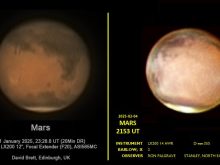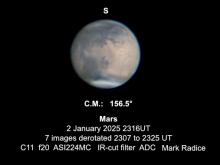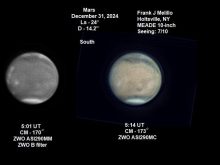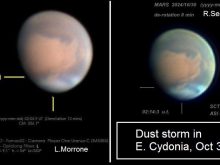Mars Opposition 2024-25
A blog of all posts for the 2024 – 2025 Opposition
Mars Opposition Blog 27 February 2025

27th February 2025
This latest post offers a very incomplete summary of the main points of interest in the recent observations up to and including February 22.
Since opposition on Jan 16 the British weather has been rather variable, and often cloudy. Early February initially looked promising, but most British observers then endured a long cloudy period of more than a fortnight after Feb 6, which only now may be ending. But worldwide coverage by 79 observers (and our Far Eastern observers have been particularly energetic) ensured that no dates were missed. See the updated list on the main page. (And as usual, I have taken images and drawings from past and previous contributors from a variety of websites, but NOT from individual BAA members’ pages. Those members must SEND me their images to me direct if they are to be included!)
I show some images by two new Section members first: David Brett (notice the evening orographic cloud over Elysium Mons) and Ron Palgrave (Solis Lacus remains large, and the Phasis streak and the little dark spot Gallinaria Silva are well seen following it).
The Director on Jan 20 noticed the blueness of the Syrtis Major upon the morning terminator. Thin cloud surrounded it, and dimmed it slightly. By this time the equatorial cloud belt had thickened. A month or so later on Feb 22 (Ls = 48) the blue scattering effect was perhaps stronger, due to the completion of the ECB after about Ls = 45. Images by Mike Karakas in blue light (for example, Jan 23, Ls = 34) show an example of the as yet incomplete ECB.
I would encourage all imagers to actually look through the eyepiece. In several cases not enough emphasis is being given to the blue channel or to the blue filter in RGB combinations, and the colour balance is unrealistic. At this season, white clouds in the morning and evening are common, but not all observers are recording them.
The wavelength-dependence of the white diurnal clouds is nicely shown by C.Pellier on Feb 1. He adds: “I’m adding a simulation to show where the ring of 6 white patches locate on the surface. The most northerly one corresponds to Alba Patera and the weakest one [just to the south] corresponds to a small dome.” See his image below.
Observers should now be looking along the terminator for any high-altitude clouds that lie beyond it. On Feb 16 Tom Williams took just such an image (which I have annotated).
Once the morning terminator is displayed to advantage after opposition, it is always exciting to be able to catch the summits of the Tharsis Montes as dark spots poking through the surrounding morning white cloud. Without having seen images of the effect this year so far, the Director made such an observation on Feb 5. And an image showing this effect by Mike Hood for Feb 18 is shown here.
We must not ignore the far southern latitudes. Here, patches of white cloud are seen in certain locations. Argyre was mentioned in earlier posts. These isolated patches will later merge to form the S. polar hood. With Hellas just past the CM on Feb 17, the Director noticed white cloud along the S. limb, but even when viewed with a blue filter it hardly impinged upon the south of the basin. And of the other visual observers, David Graham on Jan 18 noted a wide bright area (Eridania and Ausonia) along the S. limb under CML = 222-232. See his drawings below. The Director found Ausonia very bright and conspicuous on the evening side on Feb 22.
Until recently, some observers continued to find traces of a warm tint over the NPC upon their images, due to ongoing minor dust storms and dust fallout. A fine image by Martin Lewis for Jan 15 is shown here: note the thin vertical streak of dust upon the cap near the CM. But this month, activity has been much reduced. The cap too, is considerably reduced in size. Next, observers should watch out for the seasonal separation of Olympia.
In January, Mars was occulted by the Moon. Efrain Morales in Puerto Rico captured the diminutive disk of Mars near the Moon on Jan 14, and for once I will allow north to be uppermost. I noticed that several observers, including Ethan Chappel in Texas, USA, obtained images of an actual occultation.
On Feb 9 observers in the north of Scotland had a chance to see a grazing lunar occultation of Mars, or a full occultation further north. Only Callum Potter (Rousay, Orkney, 59.17 N, 3.06 W) was successful in seeing and filming both ingress and egress with his Seestar S50 (50 mm f/5 OG). His collage is shown here. And Paula Wirtanen in Helsinki, Finland, also succeeded with good images and videos of the event, and one of her stills is appended.
In my experience it is very unusual for a planet to be occulted by the Moon in two successive months. In fact, I can’t actually recall such an instance. Can anyone comment upon this?
Finally, if anyone tried to telephone me in early February they will not have succeeded, as in renewing my contract with BT, the company instead unhelpfully cut off the phone for 16 days. Perhaps this was only to be expected: that, after all, is modern service for you!
Mars Opposition Blog 20 January 2025

2025 January 20th
In the UK, the period around New Year and for nearly a fortnight afterwards was bitterly cold, with noon temperatures often staying a little below zero, and with thick frost upon lawns and foliage. Remaining for very long in the observatory always seemed to be an heroic performance. After a few cloudy days, the temperature has become more bearable. Nonetheless, some fine work has been done. This post includes data submitted up to the day of opposition (January 16).
I am posting a number of results, this time concentrating more upon observations made in the UK and Europe, and have included several from different observers for January 9-10, enabling some comparison of processing methods.
There have continued to be a number of small dust events at the edge of the cap. For example, Robert Stuart has sent me an image for January 15 where a small notch in the cap is shown on the morning side when the Syrtis Major was at the meridian. Others have confirmed this.
In the last few days the Director was struck by the slight blue tint in the Syrtis Major, glimpsed with the marking at the CM on the 15th, but more strikingly visible at the evening terminator days earlier. This coloration is due to the scattering of blue light by the thin cloud which populates the martian equator at this season (though the equatorial cloud belt is not yet complete before around Ls = 45). This effect has been shown by some images, and it has also been noticed over parts of Mare Acidalium with the marking near the morning limb. Paul Abel also remarked upon this. High resolution images have shown a small white evening cloud in the mid-latitude of the Syrtis. The orographic clouds mentioned last time are very prominent. Visually the Director noticed that the dark spot Nodus Alcyonius is still rather small and difficult to see. Will it disappear entirely, as it has in the past? And will Nepenthes ever reappear?
Tom Wiliams has submitted a remarkable video from January 3 which appears to show the shadows of evening white clouds (over Sinus Meridiani) as they rotate and reach the terminator. We have caught the long shadow of the Arsia Mons banner cloud at the appropriate season in the past, but imaging the shadows of the more usual evening equatorial clouds is (I think) a first in groundbased astronomy.
T.Akutsu imaged the martian moons on the date of opposition.
I find that my btinternet address sometimes blocks large group mailings. If you have sent something and have not had a reaction from me, please check! And if you are a new observer posting at the BAA website, please contact me directly by email in order to join the Section.
Now a final word about filenames. Whatever filename you assign to your image, and whatever its orientation, it will normally be archived by me SOUTH UPPERMOST in the following style, ending with the observer’s initials, like: 2025-01-15-2300UT-RJM. I allow variants like m20250115_2300_rjm, and so on, provided that the observer is consistent. But variants like 150125-RJM or 15Jan2025_rjm are NOT permitted. Each observer is assigned their own folder of observations in my filing system, for each apparition, and I need their images to appear in chronological order whenever it is opened. You may wish to add subdivisions of a minute of time, or the initial of any filter used before the final initials. If you want to tell me the camera or telescope or observing location or observing conditions it must all be written upon the image, or sent in an email (once per apparition will do), but not added to the filename.
Mars Opposition Blog 8 January 2025

2025 January 8
Opposition (January 16) is now just days away. As of today, the Mars Section has 64 active observers (see the updated list on the front page), and by December 31 these individuals had contributed no fewer than 3,611 images and 353 drawings. The following notes are complete up till January 3, and are necessarily highly selective.
A large number of images have shown details within the N. polar cap. Since late last year there have been some records of the high latitude annular rift within the cap (the feature that marks the outline of the permanent summer cap remnant), and this is normal, while at other times the area N. of the rift up to the N. pole has also looked dark. It seems that the latter darkening could be due to dust dispersed from the several small storms that have appeared at the edge of the seasonal cap from time to time. For example, observing visually on the evening of January 2, the Director noticed the relative darkness of the N. part of the cap, N. of the circumpolar rift, and this appearance was confirmed by the receipt, a few hours later, by an image by Mark Radice.
We have seen several active bright spots – white clouds – just north of the boundary of the cap. Frontal weather systems which move southward from the cap edge sometimes raise local dust storms in the N. hemisphere, as recent blog postings have shown.
There have been several bright orange patches – local dust storms – seen at the cap edge, and (as described and illustrated in the last posting) on occasions festoons of dust emanating from them have impinged upon the cap, the dust having a lower albedo than the latter. As the dust begins to settle (subsequently being dispersed by winds), parts of the cap briefly take on a warm tint. For example, on December 17 Foster’s images showed the morning side of the cap to be dull, and he remarked upon a warm tint there. On December 17 and 20 Gary Walker and Bill Flanagan respectively showed a complex dark dusty feature crossing the cap obliquely near the CM. Such features are darkest (and hence best seen) in blue or violet light. Particularly striking are the observations by Tiziano Olivetti and Tomio Akutsu on December 30 and 31 respectively, in which a prominent orange tendrill of suspended dust is seen cutting across the edge of the cap around longitude 300 degrees. Each successive storm lasts several days.
Since early December, Argyre has looked bright at the S. limb, particularly in the morning and evening, and its greater brightness in blue light indicates the presence of white cloud. (The southern basins do not become covered with ground frost until later in the martian year.)
Also since December, orographic clouds have been reported over all three of the Tharsis Montes. These are now quite striking near the evening limb. Alba Patera in the north also sports such an afternoon cloud, as do Elysium Mons and the great Olympus Mons. A good illustration of these clouds is to be found in Frank Melillo’s image of December 31, while on the same date Tom Williams captured the clouds earlier in the martian afternoon. As we near opposition there will be a bright patch marking the locations of the volcanoes even when they are not clouded. Such a situation is visible upon Damian Peach’s image of December 20, in which Elysium Mons and Hecates Tholus show up as very small bright spots. E-W belts of white cloud were sometimes to be seen near the edge of the NPC: for example, Flanagan on December 12 shows such a feature in N. Tempe, and Peter Tickner’s UV image on December 17 (posted here) shows another such cloud west of Casius-Utopia.
For those in Scotland, there will be a grazing occultation of Mars by the Moon on February 9 (see pages 45-46 of the 2025 Handbook). Those of us at lower latitudes will have had to make do with the lunar occultation of Saturn on January 4….
Good observing! The images are posted in chronological order here, with the earliest ones at the bottom of the page.








Mars Opposition Blog 10 December 2024

December 10
The weather has not been very cooperative lately, but we have still managed to get observations on nearly every date. This entry continues the story up till and including December 4, but is not intended to be a complete account. As ever, I can only post and discuss here a small fraction of the observations received.
Albedo feature changes are often slow and subtle, and one such example has been the gradual fading of the so-called “Aetheria darkening”, which was first apparent in the late 1970s, when a broad, triangular shading developed at the NW corner of Elysium. It was sometimes contracted to a small dark spot, but basically remained in place till recently. In 2010 there existed a tenuous streaky extension to the south, but after 2018 and the global dust storm the dark shading gradually faded. Now it has all but disappeared. Other features in the region have also changed. Trivium Charontis and Cerberus were dark areas until the late 1980s, but have progressively narrowed and faded. Thus the whole area around Elysium has seen a net accumulation of dust fallout, hiding albedo markings. Here I show comparative images by Damian Peach (UK) from 2010 and 2024, with some annotations. These really show the change well.
Of the changeable features elsewhere that have remained dark, the Indus streak from Oxia Palus to SE Mare Acidalium remains dark, and the streaky Hydaspes to the west of it remains noticeable.
In terms of high resolution imaging, Tom Williams used his new 60 cm (24-inch) reflector to obtain an amazingly detailed image on December 2. Of course, technical skill in processing is also needed for such results! Note the parallel belts of faint white cloud near the NPC, and the intricate details (for example) around the W. end of Valles Marineris at Tithonius Lacus.
The north polar hood has largely cleared now, but streaks and patches are sometimes seen in the morning.
Cutting across the N. polar cap near the CM, a coloured streak of airborne dust could be seen in the fine images by Peach and Peter Tickner (UK) on December 4. The dust streak was darker than the cap and brighter than the dark border of the cap. (See the 2010 report for an account of a conspicuous dust storm over the NPC.) Another, much less prominent dust streak at the cap edge was captured by Gary Walker (USA) at a higher longitude (close to the CM of the image, 082o) on the same date.
The orographic clouds over the Tharsis Montes are well visible in the image of November 26 by C.Foster (Namibia) shown here, which also shows cloud at Alba near the CM in the north. Notice how a blue/violet filter increases their contrast. The Alba orographic is also beautifully shown in an image of November 30 by E.Sussenbach (Dutch Caribbean), where the tailing off of the cloud to the west can be well seen. On December 2 T.Akutsu (Philippines) imaged a slight terminator projection due to high cloud, located near +2o, 202o (NE Aeolis).
I include other typical images by M.Hood (USA): note the partial morning clouds off the edge of the NPC; T.Arakawa (Japan): note the fine details NE, N and NW of the Syrtis Major, including Nodus Alcyonius; and T.Kumamori (Japan): the region of Indus and Hydaspes.
Opposition is fast approaching, so naturally more observers are joining in. The list of contributors posted on the front page has been updated, and already contains 53 names. If you are reading this as a BAA member please note that to start contributing to the Section you must first get in touch with the Director.
Expect another update shortly after the date of opposition.
Mars Opposition Blog 8 November 2024

With the US Presidential election taking place recently, I felt that some sort of parallel counting operation should be done in the UK, so on October 27 I tallied up the observations sent in to date, and there were 256 drawings and 2,285 images. I will not comment upon whether there were more blue images than red ones, but you will recall that I always hope for more blue ones! This blog post is complete up to and including Oct 31.
We have had new observations showing evening cloud over Arsia Mons and Olympus Mons (perhaps the first sign of the latter cloud). See the image by Gary Walker (USA) for Oct 23 posted here. Seasonally this is to be expected. Naturally the eye is drawn to the variable N. polar hood and its environs. Several observers have paid attention to the lower latitude of the hood in the vicinity of Mare Acidalium as well as its partial transparency over the north of the latter, while at some longitudes we have seen east-west elongated strips of cloud detached from the S. edge of the polar region.
Occasionally, frontal systems have moved off the cap to the south, and sometimes they have generated obvious small dust storms. A recent example (posted here) is a little yellow patch of dust caught in images by Luigi Morrone and Raimondo Sedrani (Italy) on Oct 30. This lay over E. Cydonia, NW of Ismenius Lacus. Note the very white morning limb cloud adjacent to the cap. Other such dust clouds at the cap/hood boundary have been seen.
Earlier, an even more dramatic storm in the form of an east-west shaped arc of dust was seen on Oct 13 by Flanagan and Mike Hood (USA), rapdily fading the next day. It was located west of the N. end of Syrtis Major, between it and Elysium. With its long dusty arc, the Oct 13 sharpened image gives a slightly unusual appearance to the planet. See the Oct 12-14 collage posted here. On this occasion the dust storm coincided with enhanced activity at the edge of the polar region. David Basey (UK) on Oct 11 drew attention to what appeared to be two bright projections off the edge of the cap, while closer inspection showed these to have been due to the presence of a horizontal cloud band that was transparent in the middle, with a dark feature (corresponding to the classical Sithonius Lacus) showing through. Sedrani captured the same activity. Johan Warell (Sweden) made a similar comment about enhanced hood activity at this longitude upon his images of Oct 12. The dust storm is the second of two recent events to have occurred near the boundaries of Elysium, an area where we know there has been a net accumulation of dust for some years now. (This is evident from the progressive fading of Cerberus, Trivium Charontis and the Aetheria dark marking.)
The N. polar hood will persist for some time into northern spring, particularly on the morning side of the disk, and in certain longitudes. N. spring (Ls = 0o) begins on Mars on Nov 12.
In the December Journal I have a note about the closely similar 1898-99 apparition, one of the earliest to be followed by the Mars Section, and I am suggesting that observers might challenge themselves to obtain images at very similar times and longitudes to the drawings published in the article, in order to make a comparison of albedo changes over 126 years. Let me know if you succeed.
| The British Astronomical Association supports amateur astronomers around the UK and the rest of the world. Find out more about the BAA or join us. |































